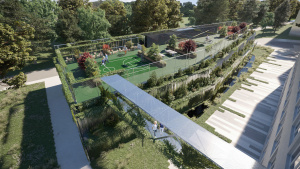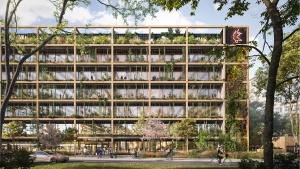In 2023 we increased the number of solar panels at CD PROJEKT’s Warsaw campus. Currently, 400 solar panels are deployed on rooftops, with an aggregate peak capacity of 135 kWp. In 2023 this array generated a total of 109 MWh of electrical energy (392 GJ), preventing the release of 75 tons of CO2 equivalent into the atmosphere.
 If you want to see how much electricity our photovoltaic panels produce, click here.
If you want to see how much electricity our photovoltaic panels produce, click here.
To improve energy management at the CD PROJEKT campus we contracted a specialized entity to perform an energy audit of our structure and carry out a series of analyses focusing, among others, on the economic and practical feasibility of implementing additional renewable energy solutions. Based on the results of this work, we prepared an investment plan which deals with improving the energy efficiency of the CD PROJEKT campus. By rolling out targeted solutions we aim to reduce our Scope 2 GHG emissions.
 Click here to check out the CD PROJEKT campus in Warsaw.
Click here to check out the CD PROJEKT campus in Warsaw.
Planned investments around our campus
- Parking lot with a rooftop recreation area. As electromobility becomes ever more popular and demand for electric car facilities increases, we’ve decided that all 129 available parking spaces will support deployment of charging stations. The rooftop of the parking lot host a recreation area comprising a crossfit zone, a meeting space and open-air workstations. In addition, we set up a rooftop basketball court. The recreation area is demarcated by a mesh fence overgrown with vines. The sheltered parking lot itself is covered by irregular, polished, perforated plates. The parking lot was opened in H1 2023.

- Office building with an underground garage. In early 2023 we’ve started constructing a six-story office building with an underground garage. The building’s structure will incorporate wooden elements, and will feature green balconies lining glass facades, each of which will be equipped with large sliding windows. This arrangement will help use external air to naturally cool down internal spaces, creating a unique work environment. External walls will be overgrown with vines and other plantlife, with an integrated watering system making use of collected rainwater. Underground spaces will host facilities for bicycle commuters. The building’s amenities will be adapted to our activity profile – we plan to include, among others, a large lecture and video screening hall, along with sound studios.
